Analyze your market like a pro with this step-by-step guide + insider tips
Don’t fall into the trap of assuming that you already know enough about your market.
No matter how fantastic your product or service is, your business cannot succeed without sufficient market demand .
You need a clear understanding of who will buy your product or service and why .
You want to know if there is a clear market gap and a market large enough to support the survival and growth of your business.
Industry research and market analysis will help make sure that you are on the right track .
It takes time , but it is time well spent . Thank me later.

WHAT is Market Analysis?
The Market Analysis section of a business plan is also sometimes called:
- Market Demand, Market Trends, Target Market, The Market
- Industry Analysis & Trends, Industry & Market Analysis, Industry and Market Research
WHY Should You Do Market Analysis?
First and foremost, you need to demonstrate beyond any reasonable doubt that there is real need and sufficient demand for your product or service in the market, now and going forward.
- What makes you think that people will buy your products or services?
- Can you prove it?
Your due diligence on the market opportunity and validating the problem and solution described in the Product and Service section of your business plan are crucial for the success of your venture.
Also, no company operates in a vacuum. Every business is part of a larger overall industry, the forces that affect your industry as a whole will inevitably affect your business as well.
Evaluating your industry and market increases your own knowledge of the factors that contribute to your company’s success and shows the readers of your business plan that you understand the external business conditions.
External Support
In fact, if you are seeking outside financing, potential backers will most definitely be interested in industry and market conditions and trends.
You will make a positive impression and have a better chance of getting their support if you show market analysis that strengthens your business case, combining relevant and reliable data with sound judgement.
Let’s break down how to do exactly that, step by step:
HOW To Do Market Analysis: Step-by-Step
So, let’s break up how market analysis is done into three steps:
- Industry: the total market
- Target Market: specific segments of the industry that you will target
- Target Customer: characteristics of the customers that you will focus on
Step 1: Industry Analysis
How do you define an industry.
For example, the fashion industry includes fabric suppliers, designers, companies making finished clothing, distributors, sales representatives, trade publications, retail outlets online and on the high street.
How Do You Analyze an Industry?
Briefly describe your industry, including the following considerations:
1.1. Economic Conditions
Outline the current and projected economic conditions that influence the industry your business operates in, such as:
- Official economic indicators like GDP or inflation
- Labour market statistics
- Foreign trade (e.g., import and export statistics)
1.2. Industry Description
Highlight the distinct characteristic of your industry, including:
- Market leaders , major customer groups and customer loyalty
- Supply chain and distribution channels
- Profitability (e.g., pricing, cost structure, margins), financials
- Key success factors
- Barriers to entry preventing new companies from competing in the industry
1.3. Industry Size and Growth
Estimate the size of your industry and analyze how industry growth affects your company’s prospects:
- Current size (e.g., revenues, units sold, employment)
- Historic and projected industry growth rate (low/medium/high)
- Life-cycle stage /maturity (emerging/expanding/ mature/declining)
1.4. Industry Trends
- Industry Trends: Describe the key industry trends and evaluate the potential impact of PESTEL (political / economic / social / technological / environmental / legal) changes on the industry, including the level of sensitivity to:
- Seasonality
- Economic cycles
- Government regulation (e.g. environment, health and safety, international trade, performance standards, licensing/certification/fair trade/deregulation, product claims) Technological change
- Global Trends: Outline global trends affecting your industry
- Identify global industry concerns and opportunities
- International markets that could help to grow your business
- Strategic Opportunity: Highlight the strategic opportunities that exist in your industry
Step 2: Target Customer Identification
Who is a target customer.
One business can have–and often does have–more than one target customer group.
The success of your business depends on your ability to meet the needs and wants of your customers. So, in a business plan, your aim is to assure readers that:
- Your customers actually exist
- You know exactly who they are and what they want
- They are ready for what you have to offer and are likely to actually buy
How Do You Identify an Ideal Target Customer?
2.1. target customer.
- Identify the customer, remembering that the decision-maker who makes the purchase can be a different person or entity than the end-user.
2.2. Demographics
- For consumers ( demographics ): Age, gender, income, occupation, education, family status, home ownership, lifestyle (e.g., work and leisure activities)
- For businesses ( firmographic ): Industry, sector, years in business, ownership, size (e.g., sales, revenues, budget, employees, branches, sq footage)
2.3. Geographic Location
- Where are your customers based, where do they buy their products/services and where do they actually use them
2.4 Purchasing Patterns
- Identify customer behaviors, i.e., what actions they take
- how frequently
- and how quickly they buy
2.5. Psychographics
- Identify customer attitudes, i.e., how they think or feel
- Urgency, price, quality, reputation, image, convenience, availability, features, brand, customer service, return policy, sustainability, eco-friendliness, supporting local business
- Necessity/luxury, high involvement bit ticket item / low involvement consumable
Step 3: Target Market Analysis
What is a target market.
Target market, or 'target audience', is a group of people that a business has identified as the most likely to purchase its offering, defined by demographic, psychographic, geographic and other characteristics. Target market may be broken down to target customers to customize marketing efforts.
How Do You Analyze a Target Market?
So, how many people are likely to become your customers?
To get an answer to this questions, narrow the industry into your target market with a manageable size, and identify its key characteristics, size and trends:
3.1. Target Market Description
Define your target market by:
- Type: B2C, B2B, government, non-profits
- Geographic reach: Specify the geographic location and reach of your target market
3.2. Market Size and Share
Estimate how large is the market for your product or service (e.g., number of customers, annual purchases in sales units and $ revenues). Explain the logic behind your calculation:
- TAM (Total Available/Addressable/Attainable Market) is the total maximum demand for a product or service that could theoretically be generated by selling to everyone in the world who could possibly buy from you, regardless of competition and any other considerations and restrictions.
- SAM (Serviceable Available Market) is the portion of the TAM that you could potentially address in a specific market. For example, if your product/service is only available in one country or language.
- SOM (Service Obtainable Market / Share of Market) is the share of the SAM that you can realistically carve out for your product or service. This the target market that you will be going after and can reasonably expect to convert into a customer base.
3.3. Market Trends
Illustrate the most important themes, changes and developments happening in your market. Explain the reasons behind these trends and how they will favor your business.
3.4. Demand Growth Opportunity
Estimate future demand for your offering by translating past, current and future market demand trends and drivers into forecasts:
- Historic growth: Check how your target market has grown in the past.
- Drivers past: Identify what has been driving that growth in the past.
- Drivers future: Assess whether there will be any change in influence of these and other drivers in the future.
How Big Should My Target Market Be?
Well, if the market opportunity is small, it will limit how big and successful your business can become. In fact, it may even be too small to support a successful business at all.
On the other hand, many businesses make the mistake of trying to appeal to too many target markets, which also limits their success by distracting their focus.
What If My Stats Look Bad?
Large and growing market suggests promising demand for your offering now and into the future. Nevertheless, your business can still thrive in a smaller or contracting market.
Instead of hiding from unfavorable stats, acknowledge that you are swimming against the tide and devise strategies to cope with whatever lies ahead.
Step 4: Industry and Market Analysis Research
The market analysis section of your business plan should illustrate your own industry and market knowledge as well as the key findings and conclusions from your research.
Back up your findings with external research sources (= secondary research) and results of internal market research and testing (= primary research).
What is Primary and Secondary Market Research?
Yes, there are two main types of market research – primary and secondary – and you should do both to adequately cover the market analysis section of your business plan:
- Primary market research is original data you gather yourself, for example in the form of active fieldwork collecting specific information in your market.
- Secondary market research involves collating information from existing data, which has been researched and shared by reliable outside sources . This is essentially passive desk research of information already published .
Unless you are working for a corporation, this exercise is not about your ability to do professional-level market research.
Instead, you just need to demonstrate fundamental understanding of your business environment and where you fit in within the market and broader industry.
Why Do You Need To Do Primary & Secondary Market Research?
There are countless ways you could go collecting industry and market research data, depending on the type of your business, what your business plan is for, and what your needs, resources and circumstances are.
For tried and tested tips on how to properly conduct your market research, read the next section of this guide that is dedicated to primary and secondary market research methods.
In any case, tell the reader how you carried out your market research. Prove what the facts are and where you got your data. Be as specific as possible. Provide statistics, numbers, and sources.
When doing secondary research, always make sure that all stats, facts and figures are from reputable sources and properly referenced in both the main text and the Appendix of your business plan. This gives more credibility to your business case as the reader has more confidence in the information provided.
Go to the Primary and Secondary Market Research post for my best tips on industry, market and competitor research.
7 TOP TIPS For Writing Market Analysis
1. realistic projections.
Above all, make sure that you are realistic in your projections about how your product or service is going to be accepted in the market, otherwise you are going to seriously undermine the credibility of your entire business case.
2. Laser Focus
Discuss only characteristic of your target market and customers that are observable, factual and meaningful, i.e. directly relate to your customers’ decision to purchase.
Always relate the data back to your business. Market statistics are meaningless until you explain where and how your company fits in.
For example, as you write about the market gap and the needs of your target customers, highlight how you are uniquely positioned to fill them.
In other words, your goal is to:
- Present your data
- Analyze the data
- Tie the data back to how your business can thrive within your target market
3. Target Audience
On a similar note, tailor the market analysis to your target audience and the specific purpose at hand.
For example, if your business plan is for internal use, you may not have to go into as much detail about the market as you would have for external financiers, since your team is likely already very familiar with the business environment your company operates in.
4. Story Time
Make sure that there is a compelling storyline and logical flow to the market information presented.
The saying “a picture is worth a thousand words” certainly applies here. Industry and market statistics are easier to understand and more impactful if presented as a chart or graph.
6. Information Overload
Keep your market analysis concise by only including pertinent information. No fluff, no repetition, no drowning the reader in a sea of redundant facts.
While you should not assume that the reader knows anything about your market, do not elaborate on unnecessary basic facts either.
Do not overload the reader in the main body of the business plan. Move everything that is not essential to telling the story into the Appendix. For example, summarize the results of market testing survey in the main body of the business plan document, but move the list of the actual survey questions into the appendix.
7. Marketing Plan
Note that market analysis and marketing plan are two different things, with two distinct chapters in a business plan.
As the name suggests, market analysis examines where you fit in within your desired industry and market. As you work thorugh this section, jot down your ideas for the marketing and strategy section of your business plan.
Final Thoughts
Remember that the very act of doing the research and analysis is a great opportunity to learn things that affect your business that you did not know before, so take your time doing the work.
Related Questions
What is the purpose of industry & market research and analysis.
The purpose of industry and market research and analysis is to qualitatively and quantitatively assess the environment of a business and to confirm that the market opportunity is sufficient for sustainable success of that business.
Why are Industry & Market Research and Analysis IMPORTANT?
Industry and market research and analysis are important because they allow you to gain knowledge of the industry, the target market you are planning to sell to, and your competition, so you can make informed strategic decisions on how to make your business succeed.
How Can Industry & Market Research and Analysis BENEFIT a Business?
Industry and market research and analysis benefit a business by uncovering opportunities and threats within its environment, including attainable market size, ideal target customers, competition and any potential difficulties on the company’s journey to success.
Sign up for our Newsletter
Get more articles just like this straight into your mailbox.
Related Posts
Recent Posts
Our Recommendations
- Best Small Business Loans for 2024
- Businessloans.com Review
- Biz2Credit Review
- SBG Funding Review
- Rapid Finance Review
- 26 Great Business Ideas for Entrepreneurs
- Startup Costs: How Much Cash Will You Need?
- How to Get a Bank Loan for Your Small Business
- Articles of Incorporation: What New Business Owners Should Know
- How to Choose the Best Legal Structure for Your Business
Small Business Resources
- Business Ideas
- Business Plans
- Startup Basics
- Startup Funding
- Franchising
- Success Stories
- Entrepreneurs
- The Best Credit Card Processors of 2024
- Clover Credit Card Processing Review
- Merchant One Review
- ProMerchant Review
- Stax Review
How to Conduct a Market Analysis for Your Business
- Local Marketing Strategies for Success
- Tips for Hiring a Marketing Company
- Benefits of CRM Systems
- 10 Employee Recruitment Strategies for Success
- Sales & Marketing
- Social Media
- Best Business Phone Systems of 2024
- The Best PEOs of 2024
- RingCentral Review
- Nextiva Review
- Ooma Review
- Guide to Developing a Training Program for New Employees
- How Does 401(k) Matching Work for Employers?
- Why You Need to Create a Fantastic Workplace Culture
- 16 Cool Job Perks That Keep Employees Happy
- 7 Project Management Styles
- Women in Business
- Personal Growth
- Best Accounting Software and Invoice Generators of 2024
- Best Payroll Services for 2024
- Best POS Systems for 2024
- Best CRM Software of 2024
- Best Call Centers and Answering Services for Busineses for 2024
- Salesforce vs. HubSpot: Which CRM Is Right for Your Business?
- Rippling vs Gusto: An In-Depth Comparison
- RingCentral vs. Ooma Comparison
- Choosing a Business Phone System: A Buyer’s Guide
- Equipment Leasing: A Guide for Business Owners
- HR Solutions
- Financial Solutions
- Marketing Solutions
- Security Solutions
- Retail Solutions
- SMB Solutions

Table of Contents
A market analysis is a thorough assessment of a market within a specific industry. These analyses have many benefits, such as reducing risk for your business and better informing your business decisions. A market analysis can be a time-intensive process, but it is straightforward and easy to do on your own in seven steps.
To perform a market analysis for your business, follow the steps outlined in this guide.
What does a market analysis include?
In a market analysis, you will study the dynamics of your market, such as volume and value, potential customer segments , buying patterns, competition, and other important factors. A thorough marketing analysis should answer the following questions:
- Who are my potential customers?
- What are my customers’ buying habits?
- How large is my target market ?
- How much are customers willing to pay for my product?
- Who are my main competitors?
- What are my competitors’ strengths and weaknesses ?
What are the benefits of running a marketing analysis?
A marketing analysis can reduce risk, identify emerging trends, and help project revenue. You can use a marketing analysis at several stages of your business, and it can even be beneficial to conduct one every year to keep up to date with any major changes in the market.
A detailed market analysis will usually be part of your business plan , since it gives you a greater understanding of your audience and competition. This will help you build a more targeted marketing strategy.
These are some other major benefits of conducting a market analysis:
- Risk reduction: Knowing your market can reduce risks in your business, since you’ll have an understanding of major market trends, the main players in your industry, and what it takes to be successful, all of which will inform your business decisions. To help you further protect your business, you can also conduct a SWOT analysis , which identifies the strengths, weaknesses, opportunities and threats for your business.
- Targeted products or services: You are in a much better position to serve your customers when you have a firm grasp on what they are looking for from you. When you know who your customers are, you can use that information to tailor your business’s offerings to your customers’ needs.
- Emerging trends: Staying ahead in business is often about being the first to spot a new opportunity or trend, and using a marketing analysis to stay on top of industry trends is a great way to position yourself to take advantage of this information.
- Revenue projections: A market forecast is a key component of most marketing analyses, as it projects the future numbers, characteristics and trends in your target market. This gives you an idea of the profits you can expect, allowing you to adjust your business plan and budget accordingly.
- Evaluation benchmarks: It can be difficult to gauge your business’s success outside of pure numbers. A market analysis provides benchmarks or key performance indicators (KPIs) against which you can judge your company and how well you are doing compared to others in your industry.
- Context for past mistakes: Marketing analytics can explain your business’s past mistakes or industry anomalies. For example, in-depth analytics can explain what impacted the sale of a specific product, or why a certain metric performed the way it did. This can help you avoid making those mistakes again or experiencing similar anomalies, because you’ll be able to analyze and describe what went wrong and why.
- Marketing optimization: This is where an annual marketing analysis comes in handy – regular analysis can inform your ongoing marketing efforts and show you which aspects of your marketing need work, and which are performing well in comparison to the other companies in your industry.
A market analysis can benefit your business in many ways, especially if you conduct regular analyses to make sure you have current information for your marketing efforts.
What are the drawbacks of running a marketing analysis?
The below drawbacks of running a market analysis pertain less to the method itself than the resources it requires.
- Market analysis can be expensive. If you’re not as familiar with marketing concepts such as market volume and customer segmentation, you might want to outsource your market analysis. Doing so can be great for your analysis’s quality, but it can also leave a big dent in your budget. Narrow your market analysis to a certain group – perhaps current customers – to lower your costs.
- Market analysis can be time-consuming. Market analysis can take precious time away from more directly business-related tasks. You can analyze one area at a time – say, buying patterns or competition – to free up your day-to-day schedule.
- Market analysis can require extra staff. Some larger companies retain in-house market analysis staff, and you can follow their lead. Doing so, though, comes with all the usual costs of hiring a new employee . The question then becomes: Do you conduct your market analysis yourself, outsource it, or hire in-house? The more expensive options can often yield more meaningful insights.
- Market analysis can be narrow. The most successful market analyses use actual customer feedback, which analysts often get through customer surveys. These surveys may reach only a portion of your entire customer base, leading to an inaccurate sample size. The result is that market analysis may not fully detail your customers and what you should know about them.
Market analysis vs. conjoint analysis vs. sentiment analysis
Where market analysis is broad and comprehensive, conjoint analysis focuses on how customers value what you offer. Surveys are often the backbone of conjoint analysis – they’re a great way for customers to share what drives their purchases. Product testing is an especially common application of conjoint analysis. This method can yield insights into pricing and product features and configurations.
Sentiment analysis goes beyond number-driven market and conjoint analysis to identify how customers qualitatively feel about your offerings. It can show you what customers are happy and unhappy about with your offerings or buying process. You can also wade into deeper emotional territory such as anger, urgency and intention, or you can dig up descriptive feedback. It’s a great tool to use alongside market analysis, whereas conjoint analysis is all but included in market analysis.
How to conduct a market analysis
While conducting a marketing analysis is not a complicated process, it does take a lot of dedicated research, so be prepared to devote significant time to the process.
These are the seven steps of conducting a market analysis:
1. Determine your purpose.
There are many reasons you may be conducting a market analysis, such as to gauge your competition or to understand a new market. Whatever your reason, it’s important to define it right away to keep you on track throughout the process. Start by deciding whether your purpose is internal – like improving your cash flow or business operations – or external, like seeking a business loan. Your purpose will dictate the type and amount of research you will do.
Use our guide to choosing a business loan to make the right decision after conducting a market analysis. Visit our business loan reviews page to find options and learn all about easy-approval options.
2. Research the state of the industry.
Map a detailed outline of the current state of your industry. Include where the industry seems to be heading, using metrics such as size, trends and projected growth, with plenty of data to support your findings. You can also conduct a comparative market analysis to help you find your competitive advantage within your specific market.
3. Identify your target customer.
Not everyone in the world will be your customer , and it would be a waste of your time to try to get everyone interested in your product. Instead, use a target market analysis to decide who is most likely to want your product and focus your efforts there. You want to understand your market size, who your customers are, where they come from, and what might influence their buying decisions. To do so, look at demographic factors like these:
During your research, you might consider creating a customer profile or persona that reflects your ideal customer to serve as a model for your marketing efforts.
4. Understand your competition.
To be successful, you need a good understanding of your competitors, including their market saturation, what they do differently than you, and their strengths, weaknesses and advantages in the market. Start by listing all your main competitors, then go through that list and conduct a SWOT analysis of each competitor. What does that business have that you don’t? What would lead a customer to choose that business over yours? Put yourself in the customer’s shoes.
Then, rank your list of competitors from most to least threatening, and decide on a timeline to conduct regular SWOT analyses on your most threatening competitors.
5. Gather additional data.
When conducting marketing analyses, information is your friend – you can never have too much data. It is important that the data you use is credible and factual, so be cautious of where you get your numbers. These are some reputable business data resources:
- U.S. Bureau of Labor Statistics
- U.S. Census Bureau
- State and local commerce sites
- Trade journals
- Your own SWOT analyses
- Market surveys or questionnaires
6. Analyze your data.
After you collect all the information you can and verify that it is accurate, you need to analyze the data to make it useful to you. Organize your research into sections that make sense to you, but try to include ones for your purpose, target market and competition.
These are the main elements your research should include:
- An overview of your industry’s size and growth rate
- Your business’s projected market share percentage
- An industry outlook
- Customer buying trends
- Your forecasted growth
- How much customers are willing to pay for your product or service
7. Put your analysis to work.
Once you’ve created a market analysis, it’s time to actually make it work for you. Internally, look for where you can use your research and findings to improve your business. Have you seen other businesses doing things that you’d like to implement in your own organization? Are there ways to make your marketing strategies more effective?
If you conducted your analysis for external purposes, organize your research and data into an easily readable and digestible document to make it easier to share with lenders.
Retain all of your information and research for your next analysis, and consider making a calendar reminder each year so that you stay on top of your market.
Making market analysis easy
If you have the time to conduct a market analysis yourself, go for it – this guide will help. If you don’t have the time, hiring an in-house expert or outsourcing your analysis is often worth the cost. Your analysis will help you figure out who to target and how – and that’s a huge part of business success.

Building Better Businesses
Insights on business strategy and culture, right to your inbox. Part of the business.com network.
How to Write and Conduct a Market Analysis

3 min. read
Updated January 3, 2024
A market is the total sum of prospective buyers, individuals, or organizations that are willing and able to purchase a business’s potential offering. A market analysis is a detailed assessment of the market you intend to enter. It provides insight into the size and value of the market, potential customer segments, and their buying patterns.
In this section, we’ll be covering what information to include in your business plan after completing your research. If you’re struggling with the research itself, you should check out our market research resources for step-by-step guidance.
- How to write your market analysis
The information featured in your market analysis should focus on firmly defining who your customers are. Here are the two steps you need to take:
Define your target market
Finding your target market requires segmentation based on demographic and psychographic information until you reach the ideal customer. You need to address who they are and how you identified them.
Target market examples
A target market analysis is a key part of any business plan. Let’s walk you through some examples.
Determine your market size
Identifying your potential customers isn’t enough. You also need to prove that the size of the market can support your business. To do this, it’s helpful to define what’s available, serviceable, and can be obtained.
Optional information to include
The main purpose of the market analysis is to show who your customers are. While defining your target market may be enough, it can be helpful to include some of the following supporting details.
Show that you know your industry
Before starting a business, you should know the state of your industry and where it’s headed. This includes industry metrics you’ve collected, any barriers to entry, emerging trends, or common success factors.

Write a customer analysis
Conducting a customer analysis provides additional depth to your target audience. You’ll know them better and go beyond just segmentation.
Use a customer persona to describe your customers
It can be difficult for you, your employees, and potential investors to visualize who your customers are based solely on data. Creating a customer persona can bring them to life and support your target market choice.
- Why conduct a market analysis?
Conducting any sort of in-depth research can be a time-intensive process. However, the benefits far outweigh the investment—so much so that it’s recommended that you revisit your market analysis at least once a year in order to stay on top of emerging trends or changes in the market.
As part of your business plan, it demonstrates that you have a firm understanding of your customers. Here are the other benefits gained by completing a market analysis:
Reduce risk
If you really understand your potential customers and market conditions, you’ll have a better chance of developing a viable product or service. It also helps you explore if your idea will work or not. If you determine that the market size can’t sustain your business, there are too many barriers, high starting costs, intense competition, or some other factor that would lead to a higher chance of failure—you can pivot and avoid wasting your hard-earned time and money.
Better position your business
Researching the market landscape will help you strategically position your business. This may be done through pricing, specific features, production/distribution, or any other method to differentiate your business and make it more attractive to your target audience.
Brought to you by
Create a professional business plan
Using ai and step-by-step instructions.
Secure funding
Validate ideas
Build a strategy
Verify product/market fit
Part of positioning your business is determining if there is a sustainable market for your business. This starts with segmenting and identifying your ideal customers. It then involves a process of gathering feedback, gauging interest, and finding any sort of demonstrable traction. To learn more about finding product market fit, check out the market research section of our Starting a Business Guide.
Inform investors
Research is not only valuable for informing you as a business owner but in convincing investors and lenders that your idea is worth funding. In many ways, the fact that you spent time pulling together viable information is just as important as the information itself. It shows that you care about finding success as a business owner and are willing to put in the work, even at this early stage.
See why 1.2 million entrepreneurs have written their business plans with LivePlan
Tim Berry is the founder and chairman of Palo Alto Software , a co-founder of Borland International, and a recognized expert in business planning. He has an MBA from Stanford and degrees with honors from the University of Oregon and the University of Notre Dame. Today, Tim dedicates most of his time to blogging, teaching and evangelizing for business planning.
.png)
Table of Contents
- Optional information
Related Articles

6 Min. Read
How to Write Your Business Plan Cover Page + Template

24 Min. Read
The 10 AI Prompts You Need to Write a Business Plan

3 Min. Read
What to Include in Your Business Plan Appendix

10 Min. Read
How to Set and Use Milestones in Your Business Plan
The Bplans Newsletter
The Bplans Weekly
Subscribe now for weekly advice and free downloadable resources to help start and grow your business.
We care about your privacy. See our privacy policy .

The quickest way to turn a business idea into a business plan
Fill-in-the-blanks and automatic financials make it easy.
No thanks, I prefer writing 40-page documents.

Discover the world’s #1 plan building software
- Sample Plans
- WHY UPMETRICS?
Upmetrics AI Assistant: Simplifying Business Planning through AI-Powered Insights. Learn How
- 400+ Sample Business Plans
Customers Success Stories
Business Plan Course
Strategic Canvas Templates
E-books, Guides & More
Business consultants
Entrepreneurs and Small Business
Accelerators and Incubators
Educators & Business Schools
Students & Scholars
AI Business Plan Generator
Financial Forecasting
AI Assistance
Ai pitch deck generator
Stratrgic Planning
See How Upmetrics Works →
Small Business Tools
Entrepreneurs & Small Business
Accelerators & Incubators
Business Consultants & Advisors
Strategic Planning
How to Write the Market Analysis Section of a Business Plan

Free Market Analysis Kit
Ayush Jalan
- December 18, 2023

Say you’re planning to launch a new product or enter a new market. How do you know what will work and what won’t? How do you ideate strategies to survive and thrive in a competitive business environment? Luckily, market analysis helps answer these questions.
After all, stepping into the world of business without proper knowledge and insight can leave you vulnerable to uncertainties and competitive pressure. A robust market analysis can help you reduce risk and ensure profitability.
In this article, we’ll see what is a market analysis, why you should conduct it, and all the steps needed to do so.
What Is Market Analysis?
Market analysis is the qualitative and quantitative study of your external business environment. It gives a complete overview of your industry and its dynamics. With market analysis, you can predict how your industry will evolve and its effects on your company over time.
What Is the Purpose of Market Analysis?
Market analysis provides you with useful insights into what works and what doesn’t. It also helps you discover untapped areas in the market and strategize to stand out from your competitors.
Without the data from market analysis, you’re more likely to make decisions based on assumptions increasing the risk of potential failure. Market analysis plays a key role in identifying where your solution falls short.
It helps you answer the following questions:
- Who is your target audience?
- What are their buying habits?
- How much are they willing to pay for your solutions?
- What is the size of your target market?
- Who are your competitors?
- What are their strengths and weaknesses?
- What are your strengths and weaknesses?
- Which opportunities and threats are visible?
- What are the current industry trends?
How Do You Collect Data for Market Analysis?
Your market analysis is valuable only if you have factual data to back up your claims. For this, there are two broad sources you can use to collect data for market research: primary and secondary .
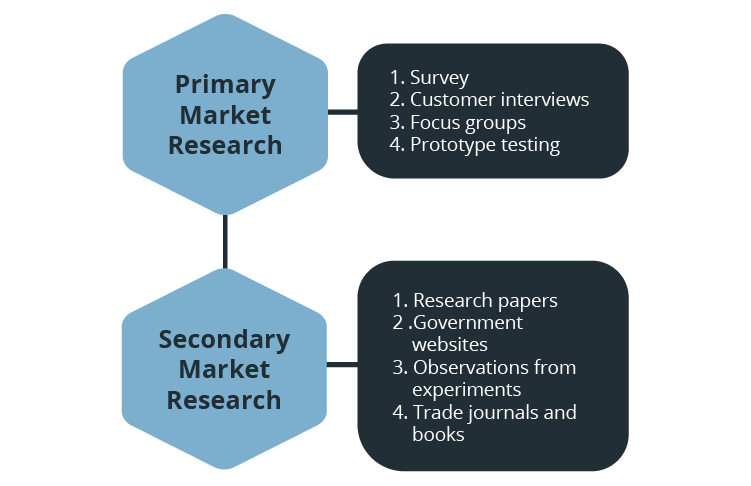
Primary market research: It includes all the information you can directly obtain yourself through:
- Market Survey
- Customer interviews
- Focus groups
- Prototype testing
Secondary market research: It includes all the data you obtain from third-party sources like:
- Research papers
- Government websites
- Observations from experiments
- Trade journals and books
However, the info you need might not always be readily available. In such cases, you can consider hiring a third-party data analytics company if you have the budget for it.
Although it can be expensive, this will enrich your analysis with accurate information. You can then use this info to gain a competitive edge over your rivals and capture a greater market share .
How to Do a Market Analysis?
Depending on the purpose and extent of your research, your market analysis can be lengthy and costly or brief and inexpensive. Regardless, there are seven steps involved in conducting a market analysis.
Step 1: State the objectives of your market analysis
Before you begin, specify the purposes of your analysis. It decides the scope of your research, keeps you on track, and helps you stick to your budget.
These are some of the reasons why you need to conduct a market analysis:
- To acquire a bank loan or investor funding
- To test a new product’s viability
- To gain a competitive edge
- To identify barriers to your growth
- To reduce uncertainty and risks
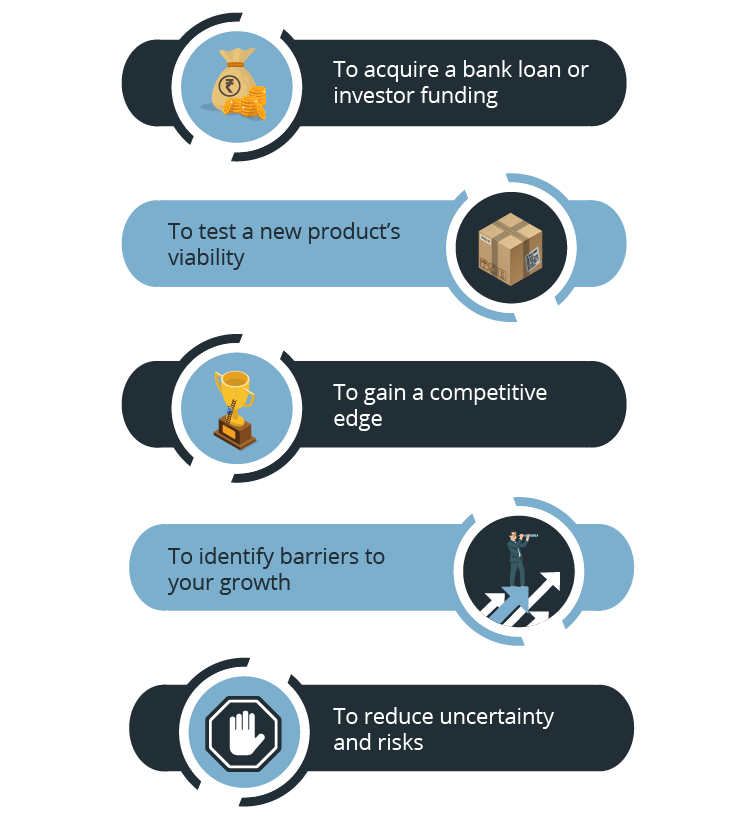
Step 2: Study your industry’s outlook
In this step, you describe the current state of your industry and make predictions on how it might change in the future. You can collect this data using metrics such as market size, projected growth, industry life cycle , and trends.
Through this data, you can understand how these changes will affect your product or service. This is especially important if you are applying for a loan or seeking funding . It also helps you forecast demand for your products to ensure profitability.
Step 3: Identify your target audience
Once you’ve outlined your industry, you identify the people most likely to buy your products and services. Even though your product might be suitable for everyone, there is a high possibility that not all of them will be your customers due to many reasons.
When you speak to everyone, you speak to no one. – Meredith Hill
To identify your ideal customer, you can gather data through surveys, focus groups, interviews, etc. Then, you can filter out the results based on demographics such as:
- Geographical location
Example: If you plan on setting up a fast-food restaurant, your ideal customer would be someone who:
- Lives in an urban area
- Has a busy lifestyle
- Travels long distances for work
- Dislikes cooking
- Falls between the age group of 12-45

Want to Create a Customer Persona in Easy Steps?
Generate valuable customer insights in minutes with our Free Customer Persona Generator .
Step 4: Analyze your competitors
One of the factors that directly impact your business is competition. There are two types of competitors you will be facing in the market.
- Direct competitors: These competitors offer similar solutions as you do. For instance, Pizza Hut is a direct competitor to Domino’s Pizza since both sell pizza as their primary product.
- Indirect competitors: These competitors offer alternate solutions that act as substitutes for your solutions. For instance, Burger King is an indirect competitor to Domino’s Pizza since both sell fast food.
On top of identifying your competitors, you should also understand how they do business. You can do this by:
- Studying their marketing strategies
- Identifying their USPs
- Specifying how big of a threat they are to you
- Determining strengths and weaknesses
- Ideating strategies to leverage their weaknesses
- Providing better solutions than they do
Step 5: Calculate your market share
Your market share is the portion of the total market sales you’re responsible for. It’s part of the market that you make up. Calculating your estimated market share, also called sales forecasting , is an important step as it will define the viability of your business venture.
If your estimated market share is not big enough, chances are your business idea might not be profitable enough to pursue due to inadequate sales. You can forecast your market share using these metrics:
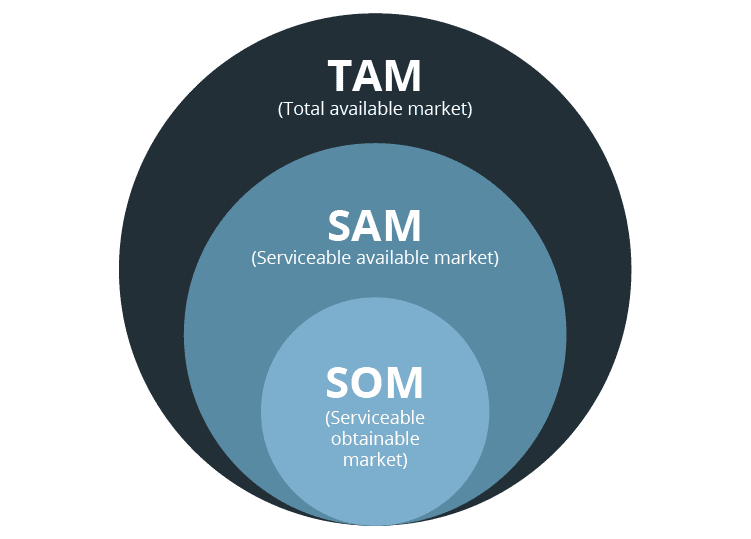
- TAM (Total available market): It represents the total demand available in the market. In other words, it is the maximum amount of sales or revenue the market has to offer.
- SAM (Serviceable available market): It represents the segment of TAM that you can obtain with your solution within your limitations. These limitations can be geographical location, business model , type of product, etc.
- SOM (Serviceable obtainable market): It represents the segment of SAM that you can capture after considering your competitors, customer preference, production capabilities, etc.
SOM is your estimated market share. Once you have calculated it, you can actualize it via suitable pricing strategies .
Example: You’re planning to set up a small pizza place somewhere in your city but you’re unsure whether it’ll be profitable. Through research, you forecast sales and gather the following data:
From the above information, you identified that your:
- TAM = $150 billion USD
- SAM = $166 million USD
- SOM = $700,000 USD
Step 6: Know the regulations and restrictions
Before entering a new market or starting a new business, you need to know the regulations and restrictions in your industry. Understanding these can help you stay out of legal pitfalls and inspire confidence in prospective investors. Some of the regulations you need to know are:
- Government policies
- Tax regulations
- Trade policies
- Employment laws
- Environmental regulations
- Security and privacy
- Protection of intellectual properties
Step 7: Organize and implement the data
Great job, you have completed the research part of the analysis. Now, it’s time to make sense of all the data you’ve gathered. Organize all the data and write a market analysis section to include in your business plan.
Follow this structure to organize and record your data:
- Market Overview
- Target market
- Direct competitors
- Indirect competitors
- Competitors’ strengths and weaknesses
- Competitive strengths and weaknesses
- Opportunities and threats
- Market share
- Projected revenue
- Regulations
Once you’re done writing the market analysis section, use this data to advance your strategic marketing process and devise a marketing plan.
Discover Blind Spots in Your Industry With a Market Analysis
You can’t scale a business on guesswork; you need reliable data to back every step you take in your business roadmap . As we saw above, market analysis is the perfect tool for this purpose. It helps you identify gaps in the market, overcome threats, and understand industry dynamics.
Conduct market analysis regularly to stay on top of industry trends and gain a competitive edge in an ever-changing business environment.
Build your Business Plan Faster
with step-by-step Guidance & AI Assistance.

About the Author

Ayush is a writer with an academic background in business and marketing. Being a tech-enthusiast, he likes to keep a sharp eye on the latest tech gadgets and innovations. When he's not working, you can find him writing poetry, gaming, playing the ukulele, catching up with friends, and indulging in creative philosophies.
Related Articles

How to Write a Customer Analysis Section for Your Business Plan

5 Types Of Competitive Analysis Frameworks

Strategic Marketing Process: A Full Step-by-Step Guide
Reach your goals with accurate planning.
No Risk – Cancel at Any Time – 15 Day Money Back Guarantee
Popular Templates

Plan Smarter, Grow Faster:
25% Off Annual Plans! Save Now

0 results have been found for “”
Return to blog home
How to Conduct a Market Analysis in 4 Steps — 2024 Guide
Posted february 5, 2021 by noah parsons.

Understanding your customers is the key to success for any startup. If you don’t have a deep understanding of who your customers are, you’ll have trouble developing products that truly fit their needs, and you’ll struggle to develop a successful marketing strategy.
This is where a market analysis comes in. It may sound like a daunting and complex process, but fortunately, it’s not.
What is a market analysis?
A market analysis is a thorough qualitative and quantitative assessment of the current market .
It helps you understand the volume and value of the market, potential customer segments and their buying patterns, the position of your competition, and the overall economic environment, including barriers to entry, and industry regulations.
Why you should conduct a market analysis
Whether you are writing a one-page plan or putting together a detailed business plan for a bank or other investor, a solid market analysis is expected. But, don’t just do a market analysis because you’re developing a plan. Do it because it will help you build a smarter strategy for growing your business.
Once you have in-depth knowledge of your market, you’ll be better positioned to develop products and services that your customers are going to love. And while diving into market research may seem like a daunting task it can be broken up into four simple elements:
- Industry overview: You’ll describe the current state of your industry and where it is headed.
- Target market: Who are your actual customers? You’ll detail how many of them are there, what their needs are, and describe their demographics.
- Competition: Describe your competitors’ positioning, strengths, and weaknesses.
- Pricing and forecast: Your pricing will help determine how you position your company in the market, and your forecast will show what portion of the market you hope to get.
How to conduct a market analysis
Now, let’s go into each step in more detail so you know exactly what you need for your market analysis.
1. Industry overview
In this step, you’ll describe your industry and discuss the direction that it’s headed. You’ll want to include key industry metrics such as size, trends, and projected growth.
Industry research and analysis is different than market research . When you’re researching your industry, you’re looking at all of the businesses like yours. This is different than market research, where you are learning about your customers.
Your industry overview shows investors that you understand the larger landscape that you are competing in. More importantly, it helps you understand if there’s going to be more demand for your products in the future and how competitive the industry is likely to be.
For example, if you are selling mobile phones, you’ll want to know if the demand for mobile phones is growing or shrinking. If you’re opening a restaurant, you’ll want to understand the larger trends of dining out. Are people eating at restaurants more and more over time? Or is the market potentially shrinking as consumers take advantage of grocery delivery services?
If you’re in the United States, the U.S. Census has excellent industry data available . I’ve also found Statista to be useful. You should also look up your industry association—they often have a wealth of information on the trends in your industry.
2. Define your target market
Your target market is the most important section of your industry analysis. This is where you explain who your ideal customer is.
You may find that through the course of your analysis, that you identify different types of customers. When you have more than one type of customer, you do what’s called market segmentation. This is where you group similar types of customers into segments and describe the attributes of each segment.
You’ll need to start broadly and refine your research by defining the following elements.
Market size
Unlike industry size, which is usually measured in dollars, your market size is how many potential customers there are for your product or service. We’ve got a great method for figuring out your market size that you can read about here .
Demographics
Describe your customer’s typical age, gender, education, income, and more. If you could paint a picture of your perfect customer, this is where you’ll describe what they look like.
Where are your customers located? A specific country, region, state, city, county, you’ll want to describe that here. You may even find that your customer base is segmented based on location which can help you determine where you’ll be doing business.
Psychographics
It’s here that you need to get inside the mindset of your customers, know their needs, and how they’ll react. What are your customers’ likes and dislikes? How do they live? What’s their personality?
This piece can even help you better approach analyzing the competition.
This is essentially an extension of some of your psychographic information. Explain how your customers shop for and purchase products like yours.
Customer behavior is always changing. If there are trends that you’ve noticed with your target market, detail them here.
3. Competition
Your market analysis isn’t complete without thinking about your competition . Beyond knowing what other businesses you are competing with, a good competitive analysis will point out competitors’ weaknesses that you can take advantage of. With this knowledge, you can differentiate yourself by offering products and services that fill gaps that competitors have not addressed.
When you are analyzing the competition, you should take a look at the following areas.
Direct competition
These are companies that are offering very similar products and services. Your potential customers are probably currently buying from these companies.
Indirect competitors
Think of indirect competition as alternative solutions to the problem you are solving. This is particularly useful and important for companies that are inventing brand new products or services. For example, the first online task management software wasn’t competing with other online task managers—it was competing with paper planners, sticky notes, and other analog to-do lists.
How you’re different
You don’t want to be the same as the competition. Make sure to discuss how your company, product, or service is different than what the competition is offering. For a common business type, such as hair salons, your differentiation might be location, hours, types of services, ambiance, or price.
Barriers to entry
Describe what protections you have in place to prevent new companies from competing with you. Maybe you have a great location, or perhaps you have patents that help protect your business.
The best way to research your competition is to talk to your prospective customers and ask them who they are currently buying from and what alternate solutions they are using to solve the problem you are solving. Of course, spending some time on Google to figure out what else is out there is a great idea as well.
4. Pricing and forecast
The final step in a market analysis is to figure out your pricing and create a sales forecast to better understand what portion of the market you think you can get.
Pricing your product or service
First, think about your pricing . Of course, you should ensure that your price is more than what it costs you to make and deliver your product or service. But, beyond that, think about the message that your price sends to consumers.
Customers usually link high prices to quality. But, if you are pricing on the higher end of the spectrum, you need to make sure the rest of your marketing is also signaling that you are delivering a high-quality product or service. From what your business looks like to its logo and customer service experience, high-prices should come with a high-quality experience during the entire sales process.
On the other end of the spectrum, maybe you’re competing as a low-priced alternative to other products or businesses. If that’s the case, make sure your marketing and other messaging are also delivering that same, unified message.
Forecasting for initial sales volume
Once you have an idea of your pricing, think about how much you expect to sell. Your industry research will come into play here as you think about how much of the overall market you expect to capture. For example, if you’re opening a new type of grocery store, you’ll want to know how much people spend on groceries in your area. Your forecast should reflect a realistic portion of that total spend. It’s probably not realistic to gain 50 percent of the market within your first year.
However, don’t make the mistake of assuming that you can easily get 1 percent of a very large market. 1 percent of a 3 billion dollar market is still $30 million and even though 1 percent seems like a small, attainable number, you need to understand and explain how you will actually acquire that volume of customers.
When you build your forecast, use it as a goal for your business and track your actual sales compared to what you had hoped you would sell. Tools like LivePlan can help you automatically compare your forecast to your accounting data, so it’s easy to do. But, even if you use a spreadsheet, tracking your progress will help you adjust your business strategy quickly so that you can do more of what’s working and less of what isn’t.
Prepare your business with a market analysis
Creating a good market analysis is a very worthwhile exercise. It will help you uncover your blind spots and prepare you to compete with other businesses. More importantly, it will help you understand your customers so you can deliver the best possible service to them.
Looking for some examples of market analysis? Take a look at our free sample business plans on Bplans . There are more than 500 of them across a wide range of industries, and each one of them has a market analysis section.
Editor’s note: This article was originally published in 2018 and updated for 2021.
Like this post? Share with a friend!
Noah Parsons
Posted in business plan writing , management, join over 1 million entrepreneurs who found success with liveplan, like this content sign up to receive more.
Subscribe for tips and guidance to help you grow a better, smarter business.
You're all set!
Exciting business insights and growth strategies will be coming your way each month.
We care about your privacy. See our privacy policy .
- Search Search Please fill out this field.
- Building Your Business
- Becoming an Owner
- Business Plans
How to Write a Business Plan: Target Market Analysis
The Business Plan and the Importance of Defining Your Target Market
Susan Ward wrote about small businesses for The Balance for 18 years. She has run an IT consulting firm and designed and presented courses on how to promote small businesses.
:max_bytes(150000):strip_icc():format(webp)/SusanWardLaptop2crop1-57aa62eb5f9b58974a12bac9.jpg)
Conducting a Market Analysis
Polling your target market, writing the market analysis, online tools for market research, u.s. online market research sources, canadian online market research, local sources of market research, doing your own market research.
Creative Commons CC0
The market analysis is basically the target market section of your business plan . It is a thorough examination of the ideal people to whom you intend to sell your products or services.
Even if you intend on selling a product or service only in your community, you won't be selling that service to everyone who lives there. Knowing exactly what type(s) of people might be interested in buying your product or service and how many of them reside in your projected area or region is fundamental in creating your market analysis.
Once target market data has been established, you'll also work on sales projections within specific time frames, as well as how prospective sales might be affected by trends and policies.
Research is key and cornerstone of any solid business plan .
Don't Skip This Step!
Don't skip market research; otherwise, you could end up starting a business that doesn't have a paying market.
Use these general terms as linchpins in research data for the market analysis section of your business plan, and to identify your target market:
But don't stop here. To succinctly define your target market, poll or survey members of your prospective clients or customers to ask specific questions directly related to your products or services. For instance, if you plan to sell computer-related services, ask questions relating to the number of computing devices your prospective customers own and how often they require servicing. If you plan on selling garden furniture and accessories, ask what kinds of garden furniture or accessories your potential customers have bought in the past, how often, and what they expect to buy within the next one, three, and five years.
Answers to these and other questions related to your market are to help you understand your market potential.
The goal of the information you collect is to help you project how much of your product or service you'll be able to sell. Review these important questions you need to try to answer using the data you collect:
- What proportion of your target market has used a product similar to yours before?
- How much of your product or service might your target market buy? (Estimate this in gross sales and/or in units of product/service sold.)
- What proportion of your target market might be repeat customers?
- How might your target market be affected by demographic shifts?
- How might your target market be affected by economic events (e.g. a local mill closing or a big-box retailer opening locally)?
- How might your target market be affected by larger socio-economic trends?
- How might your target market be affected by government policies (e.g. new bylaws or changes in taxes)?
One purpose of the market analysis is to ensure you have a viable business idea.
Find Your Buying Market
Use your market research to make sure people don't just like your business idea, but they're also willing to pay for it.
If you have information suggesting that you have a large enough market to sustain your business goals, write the market analysis in the form of several short paragraphs using appropriate headings for each. If you have several target markets, you may want to number each.
Sections of your market analysis should include:
- Industry Description and Outlook
- Target Market
- Market Research Results
- Competitive Analysis
Remember to properly cite your sources of information within the body of your market analysis as you write it. You and other readers of your business plan, such as potential investors, will need to know the sources of the statistics or opinions that you've gathered.
There are several online resources to learn if your business idea is something worth pursing, including:
- Keyword searches can give you an overall sense of potential demand for your product or service based on the number of searches.
- Google Trends analysis can tell you how the number of searches has changed over time.
- Social media campaigns can give you an indication of the potential customer interest in your business idea.
The U.S. Small Business Administration (SBA) has information on doing your market research and analysis , as well as a list of free small business data and trends resources you can use to conduct your research. Consider these sources for data collection:
- SBA Business Data and Statistics
- The U.S. Census Bureau maintains a huge database of demographic information that is searchable by state, county, city/town, or zip code using its census data tool . Community, housing, economic, and population surveys are also available.
- The U.S. Department of Commerce Bureau of Economic Analysis (BEA) has extensive statistics on the economy including consumer income/spending/consumption, business activity, GDP, and more, all of which are searchable by location.
The Government of Canada offers a guide on doing market research and tips for understanding the data you collect. Canadian data resources include:
- Statistics Canada offers demographic and economic data.
- The Business Development Bank of Canada (BDC) offers market research and consulting with industry experts.
- The Canada Business Network provides business information to entrepreneurs by province/territory, including market research data.
There are also a great many local resources for building target market information to explore, including:
- Local library
- Local Chamber of Commerce
- Board of Trade
- Economic Development Centre
- Local government agent's office
- Provincial business ministry
- Local phone book
All of these will have information helpful in defining your target market and providing insights into trends.
The above resources are secondary sources of information, in which others have collected and compiled the data. To get specific information about your business, consider conducting your own market research . For instance, you might want to design a questionnaire and survey your target market to learn more about their habits and preferences relating to your product or service.
Market research is time-consuming but is an important step in affording your business plan validity. If you don't have the time or the research skills to thoroughly define your target market yourself, hiring a person or firm to do the research for you can be a wise investment.
Small Business Administration. " Market Research and Competitive Analysis. " Accessed Jan. 13, 2020.
How to do a market analysis?
Analysing a market can be tough which is why The Business Plan Shop has put together this practical guide where we go through all the steps needed to obtain and utilise market analysis for your business.
In this market analysis guide:
- What is market analysis?
- Steps & tips to do a market analysis
- Market analysis and business planning
- Our market analysis guides by business activity
- Market analysis FAQ

1. What is market analysis?
Definition and key uses of market analysis.
Market analysis is the process of gathering, analyzing, and interpreting data about a particular market. It involves looking at both the demand (customers) and supply side (your competitors), and the industry as a whole (regulation, supply chain, etc.).
Conducting a market analysis helps businesses like yours achieve the following objectives:
- Position the business with a concept that is likely to be popular within your chosen location, and yet differentiated from competition
- Evaluate the commercial potential for your business on the local market - how much sales can you generate in the coming years?
- Gather the data necessary to start using the market analysis by developping a concrete business plan for your venture
For startups and existing businesses alike, conducting regular market analysis can help reduce many of the risks associated with running a business.
This is because you'll be asking yourself key questions such as which customer segments are best to target, what services to offer to meet their need, and how to gain and defend market share from competitors.
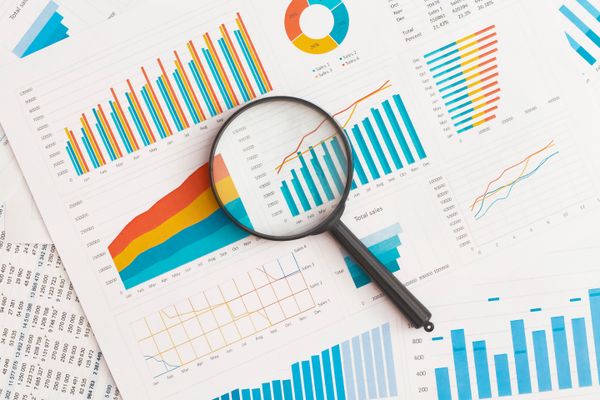
2. Steps & tips to do a market analysis
What are the key steps in market analysis.
There are five key steps in market analysis. Let's take a look at each one in more detail.
- Current industry trends and regulations: understanding how trends are evolving and regulation is changing helps you identify the direction in which the market is moving and any legal or compliance factors that may impact your business.
- Demand in your serviceable area: this involves analysing whether there is demand for your products or services in your chosen area. It helps you assess whether there is a sufficient market for your offerings. It involves researching potential customers, their needs, and purchasing behavior. Related: what is TAM SAM SOM .
- Direct and indirect competition: this involves evaluating both direct competitors and indirect competitors. Doing so helps you understand the competitive landscape, verify that the market is not saturated and identify potential gaps or niches to exploit.
- Unique Selling Proposition (USP): this involves developing a point of difference to set your business apart from competitors. Why should customers choose your products or services over others in the market?
- Validate the USP or new positioning: once you've identified your USP or new positioning, it's important to validate it with your target market. This can involve conducting surveys, focus groups, or other research methods to ensure that your USP resonates with potential customers and meets their needs.

3 tips for more impactful market research and analysis
Primary research (data collected firsthand) is likely to be of greater importance to your business than secondary research. You should perform extensive research on customers, suppliers and competitors in your local or addressable market to form an accurate picture of the overall market.
Whilst secondary research (existing data and reports) may not always be totally up-to-date, it can provide valuable context and save time and resources. Using secondary research to supplement your primary research is perhaps the best way to go about it.
Document your market analysis findings in your business plan as this helps demonstrate to investors and lenders that you understand your market well.

3. Market analysis and business planning
Business planning is the logical next steps after market analysis.
Market analysis is a vital routine for both small and large businesses. It's necessary when they start, expand into new markets, launch new products or services, or just to stay updated and competitive.
In order to use the results of a market analysis and make it actionable, the next step is to start creating a financial forecast to assess how much sales and profit the business is likely to make in the years to come.
Multiple scenarios can be brainstormed until you start forming a view of what is going to be the central case in your business plan.
Depending on your circumstances, the business plan can be used internally, or used to secure funding from investors or lenders.
A fully fledged business plan written to secure financing will contain a dedicated market analysis section in which you should include comprehensive information about your target market, competitors and trends amongst other things.
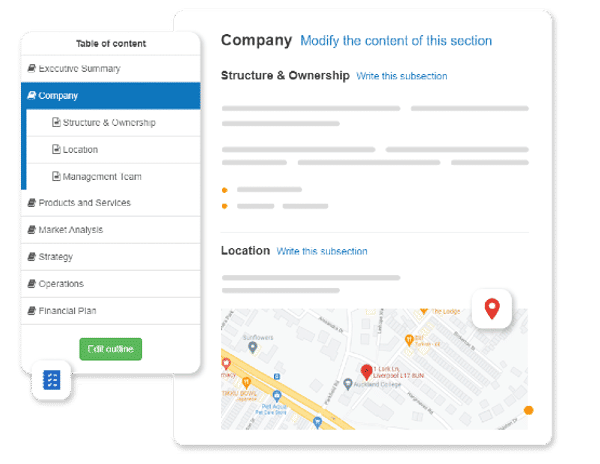
How a platform like The Business Plan Shop can help you write a professional business plan
Using a platform like The Business Plan Shop is usually the next logical step after completing market analysis as the data is used as a key input during the business planning and forecasting processes.
We help you write a business plan by providing guidance at every step, through examples, instructions, ensuring your plan follows the structure investors & lenders expect. You'll also be able to plan growth, anticipate future cash flows with confidence and check that you are on track to deliver your forecasts.
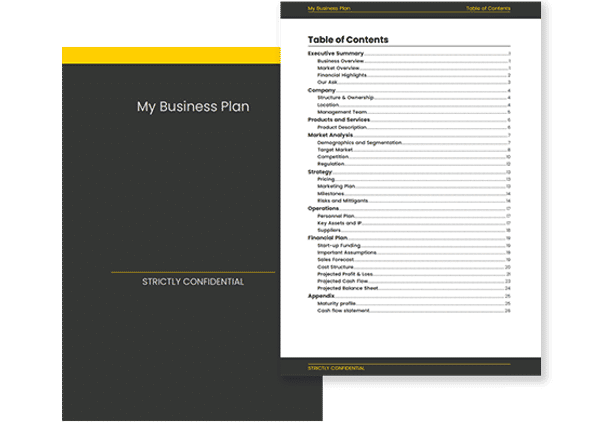
Frequently Asked Questions About Market Analysis
Market analysis is the process of gathering, analyzing, and interpreting data about a particular market.
Here are some of the key reasons as to why market analysi is important for your business:
- Understanding customer needs: market research and analysis help you gain insights into your target customers' needs, preferences, and behaviors. This information allows you to tailor your products or services to meet customer demands more effectively.
- Identify gaps in the market: it allows you to identify underserved customer segments or geographical areas.
- Analyse competiton: market analysis helps you assess your competitors, their strengths, weaknesses, and strategies. This knowledge enables you to differentiate your business and develop a competitive advantage over time.
- Set realistic goals: knowing where your market is headed helps set realistic goals for your business that you can achieve and aim towards within the next 3 or 5 years.
- Reduce risk: market research can help prevent costly mistakes. It allows you to test concepts and ideas before committing significant resources, potentially saving time and money.
Ultimately, it helps you make informed decisions, reduces risks, identifies opportunities, and contributes to the long-term success and sustainability of your business.
There are four key approaches to market research: primary, secondary, quantitative and qualitative.
Let's look at each one in more detail:
- Primary research: this involves collecting data first-hand, usually from individuals or groups. It is valuable for obtaining data tailored to your research objectives and can provide fresh insights. Common methods of primary research include surveys, interviews, observations, and focus groups.
- Secondary research: collates existing information or research for analysis. The main benefit of this is that it can be cost-effective and time-saving as it relies on already available data sources like market reports, industry publications, academic studies and government statistics.
- Quantitative research: this focuses on collecting and analyzing numerical data to quantify relationships and patterns. It usually involves structured surveys, questionnaires, experiments, and statistical analysis. The main aim is to measure specific variables test hypotheses, generalize findings to a larger population and provide precise, numerical results that are often used for statistical analysis.
- Qualitative research: emphasizes understanding behaviours, attitudes, motivations, and perceptions through non-numerical data. In-depth interviews, focus groups and content analysis are three common examples of qualitative research. This method aims to extract information about what people think and why they hold that opinion.
Using all four research approaches together can provide a more comprehensive understanding of the overall market and increases the likelihood that your conclusions are accurate.
Market research and market analysis are related but distinct processes used by businesses to understand and evaluate market conditions, opportunities, and potential strategies.
Let's take a look at each of them in detail:
- Market research focuses on gathering data related to a specific market, including its size, demographics, trends, customer preferences, competition, and more. It involves both primary and secondary research and is typically conducted as a preliminary step.
- Market analysis is the process of evaluating and interpreting the collected market research data to make informed business decisions. It is, therefore, the next step after conducting market research. It focuses on the analysis of data, drawing conclusions, and developing strategies based on the insights obtained from market research. Unlike market research, market analysis is a key section of any business plan.
In summary, market research is the process of gathering data and insights about a market, while market analysis involves interpreting that data to make strategic decisions. Both are integral to the development of a business plan, with market analysis being a core component used to create a strategic roadmap for a business.
Whether or not you need to hire a market research company as a business depends on various factors, including your specific research needs, available resources, expertise, and the complexity of the research required.
Here are some considerations to help you decide:
- Nature and scope: assess the nature and scope of your research needs. If you require in-depth, specialized, or large-scale market research that is beyond the capabilities of your internal team, hiring a market research company with expertise in your industry or area of interest may be beneficial.
- Expertise: consider the expertise and experience of your internal team. If your team lacks the necessary skills and knowledge to design and execute effective market research studies, it may be advantageous to bring in external experts.
- Loss of control: on the flip side, when you hire an external research company, you are relinquishing some control over the research process. You may not have direct oversight of every aspect of the study, which can lead to concerns about the quality of the data collection and analysis.
- Cost: hiring a market research company can often be very expensive and is probably unfeasible for the vast majority of small businesses.
Overall, hiring a market research firm has its advantages, though it's generally not something small businesses do, and it's important to weigh up the potential benefits against the drawbacks and costs involved before making a decision.
Try The Business Plan Shop for free!
Have your market analysis ready? It's time to put it to use inside The Business Plan Shop: create a financial forecast to form a view on the sales potential for your business today.
Free 7-day trial. No credit card required.

- Pre-Markets
- U.S. Markets
- Cryptocurrency
- Futures & Commodities
- Funds & ETFs
- Health & Science
- Real Estate
- Transportation
- Industrials
Small Business
Personal Finance
- Financial Advisors
- Options Action
- Buffett Archive
- Trader Talk
- Cybersecurity
- Social Media
- CNBC Disruptor 50
- White House
- Equity and Opportunity
- Business Day Shows
- Entertainment Shows
- Full Episodes
- Latest Video
- CEO Interviews
- CNBC Documentaries
- CNBC Podcasts
- Digital Originals
- Live TV Schedule
- Trust Portfolio
- Trade Alerts
- Meeting Videos
- Homestretch
- Jim's Columns
- Stock Screener
- Market Forecast
- Options Investing
- Chart Investing
Credit Cards
Credit Monitoring
Help for Low Credit Scores
All Credit Cards
Find the Credit Card for You
Best Credit Cards
Best Rewards Credit Cards
Best Travel Credit Cards
Best 0% APR Credit Cards
Best Balance Transfer Credit Cards
Best Cash Back Credit Cards
Best Credit Card Welcome Bonuses
Best Credit Cards to Build Credit
Find the Best Personal Loan for You
Best Personal Loans
Best Debt Consolidation Loans
Best Loans to Refinance Credit Card Debt
Best Loans with Fast Funding
Best Small Personal Loans
Best Large Personal Loans
Best Personal Loans to Apply Online
Best Student Loan Refinance
All Banking
Find the Savings Account for You
Best High Yield Savings Accounts
Best Big Bank Savings Accounts
Best Big Bank Checking Accounts
Best No Fee Checking Accounts
No Overdraft Fee Checking Accounts
Best Checking Account Bonuses
Best Money Market Accounts
Best Credit Unions
All Mortgages
Best Mortgages
Best Mortgages for Small Down Payment
Best Mortgages for No Down Payment
Best Mortgages with No Origination Fee
Best Mortgages for Average Credit Score
Adjustable Rate Mortgages
Affording a Mortgage
All Insurance
Best Life Insurance
Best Homeowners Insurance
Best Renters Insurance
Best Car Insurance
Travel Insurance
All Credit Monitoring
Best Credit Monitoring Services
Best Identity Theft Protection
How to Boost Your Credit Score
Credit Repair Services
All Personal Finance
Best Budgeting Apps
Best Expense Tracker Apps
Best Money Transfer Apps
Best Resale Apps and Sites
Buy Now Pay Later (BNPL) Apps
Best Debt Relief
All Small Business
Best Small Business Savings Accounts
Best Small Business Checking Accounts
Best Credit Cards for Small Business
Best Small Business Loans
Best Tax Software for Small Business
Filing For Free
Best Tax Software
Best Tax Software for Small Businesses
Tax Refunds
Tax Brackets
Tax By State
Tax Payment Plans
All Help for Low Credit Scores
Best Credit Cards for Bad Credit
Best Personal Loans for Bad Credit
Best Debt Consolidation Loans for Bad Credit
Personal Loans if You Don't Have Credit
Best Credit Cards for Building Credit
Personal Loans for 580 Credit Score or Lower
Personal Loans for 670 Credit Score or Lower
Best Mortgages for Bad Credit
Best Hardship Loans
All Investing
Best IRA Accounts
Best Roth IRA Accounts
Best Investing Apps
Best Free Stock Trading Platforms
Best Robo-Advisors
Index Funds
Mutual Funds
Biden signs $1.2 trillion spending package for government funding until October

- President Biden signed Congress' $1.2 trillion spending package into law, hours after the Senate passed at 2 a.m. ET Saturday morning.
- Congress approved $459 billion for the first six appropriations bills earlier in March.
- Biden's approval of this final tranche of bills ends a months-long saga of lawmakers struggling to secure a permanent budget resolution and instead passing stopgap measures to keep the government's lights on.
President Joe Biden on Saturday signed Congress ' $1.2 trillion spending package, finalizing the remaining batch of bills in a long-awaited budget to keep the government funded until Oct. 1.
Almost halfway into the fiscal year, the president's signature ends a months-long saga of Congress struggling to secure a permanent budget resolution and instead passing stopgap measures, nearly averting government shutdowns.
"The bipartisan funding bill I just signed keeps the government open, invests in the American people, and strengthens our economy and national security," Biden said in a Saturday statement. "This agreement represents a compromise, which means neither side got everything it wanted."
The weekend budget deal slid in just under the wire before the Friday midnight funding deadline, as has been typical this fiscal year with eleventh-hour disagreements derailing near-complete deals.
The Senate passed the budget in a 74-24 vote at roughly 2 a.m. ET Saturday morning, technically two hours after the deadline due to last-minute disagreements. However, the White House said that it would not begin official shutdown operations since a deal had ultimately been secured and only procedural actions remained.
The House passed its own vote Friday morning after a week of scrambling to reconcile a lingering sticking point: funding for the Department of Homeland Security, which the White House took issue with last weekend. The White House's qualms delayed the negotiation process further, just as lawmakers were preparing to release the legislative text of the budget proposal.
This trillion-dollar tranche of six appropriation bills will fund agencies related to defense, financial services, homeland security, health and human services and more. Congress approved $459 billion for the first six appropriations bills earlier in March, which related to agencies that were less partisan and easier to negotiate.
With the government finally funded for the rest of the fiscal year, House Speaker Mike Johnson, R-La., has cleared his plate of at least one looming issue.
But in so doing, he may have created another.
Hours before the House passed the spending package Friday morning, hardline House Republicans held a press conference to lambast the bill. Moments after the House narrowly passed the bill, far-right Georgia Republican Rep. Marjorie Taylor Greene filed a motion to oust Johnson.
If ousting a House speaker for budget disagreements feels like a familiar story, that's because it is.
In October, after former Speaker Kevin McCarthy struck a deal with Democrats to avert a government shutdown, the House voted to remove him, making him the first Speaker in history to be removed from that position. Johnson has been trying to appease the hardline Republican wing of the House, called the Freedom Caucus, to avoid meeting a similar fate.
Baltimore Port: What impact will bridge collapse have on shipping?

PORT FEATURES
Current status of cargo ships inside port, cruise ships, london metal exchange warehouses, bunker fuel.
Get weekly news and analysis on the U.S. elections and how it matters to the world with the newsletter On the Campaign Trail. Sign up here.
Reporting by Josephine Mason, Nick Carey, Helen Reid, Jonathan Saul, Nigel Hunt, Marwa Rashad, Scott DiSavino, Shariq Khan and Eric Onstad; Compiled by Josephine Mason and Nina Chestney; Editing by Nick Macfie and Nick Zieminski
Our Standards: The Thomson Reuters Trust Principles. , opens new tab

Philippines' Marcos boosts maritime security as China tension rises
Philippine President Ferdinand Marcos Jr has ordered his government to strengthen its coordination on maritime security to confront "a range of serious challenges" to territorial integrity and peace, as a dispute with China escalates.

The head of Ukraine's largest private energy firm, DTEK, said on Saturday that five of its six plants had been damaged or destroyed with 80% of its generating capacity lost after two weeks of Russian attacks and that repairs could take up to 18 months.
Three United Nations observers and a translator were wounded on Saturday when a shell exploded near them as they were carrying out a foot patrol in south Lebanon, the U.N. peacekeeping mission said, adding it was still investigating the origin of the blast.

Advertisement
Supported by
Trump Media Merger Provides Trump a Potential Cash Lifeline
Having closed the merger of his social media company, Mr. Trump could find ways to raise cash against the value of his stake in the company, estimated at more than $3 billion.
- Share full article

By Matthew Goldstein
Former President Donald J. Trump’s social media company — and the parent of his favorite communications platform, Truth Social — became a public company on Friday through a merger that will raise Mr. Trump’s wealth by billions of dollars and potentially help pay his mounting legal bills.
Trump Media & Technology Group is poised to debut on Wall Street at a market value of around $5 billion — based on the $37 share price of its merger partner, Digital World Acquisition Corp. Given that Mr. Trump owns more than 60 percent of the company, his overall net worth will increase by $3 billion — instantly doubling his wealth from the $2.6 billion estimate by Forbes magazine in October.
So far, those gains are on paper, and Mr. Trump is unlikely to be able to quickly turn it into cash because of restrictions in the merger agreement that prevent major shareholders from selling shares for at least six months, or using them as collateral for loans. But because Mr. Trump controls so much of Trump Media, and because his allies are expected to make up a majority of the new board, they could waive those restrictions on his request.
The question of where Mr. Trump can raise cash has become an urgent one because he is on the hook for hundreds of millions of dollars of legal bills tied to the multiple cases against him. Mr. Trump is facing a Monday deadline to cover a $454 million penalty in a civil fraud case brought by the New York State attorney general, which accuses him of greatly inflating the value of his real estate holdings in deals with banks.
If Mr. Trump cannot come up with the cash or a bond to cover the penalty while he appeals the ruling, the attorney general’s office could seize some of his properties.
Trump Media’s board might be reluctant to allow Mr. Trump to sell shares early as that would likely deflate the company’s share price. But lifting the restriction on using shares as collateral would help him secure a bond and minimize the negative impact on the stock price.
Before the merger closed, Mr. Trump was chairman of Trump Media but neither it nor Digital World disclosed whether he will continue to retain the title. Either way, Mr. Trump will hold enormous sway over the company as the company’s new seven-member board includes Mr. Trump’s eldest son, Donald Trump Jr., and three former members of his administration. His 79 million shares give him a large majority stake in the company and his brand is critical to the success of Truth Social, which has become his main megaphone with communicating to his supporters.
There is no guarantee that the stock of Trump Media will continue to trade at its current levels. If the share price falls over the coming months, the sizable increase to his net worth could be smaller over time. Digital World’s shares dropped about 14 percent after the shareholder vote approving the merger.
As part of the merger, investors in Digital World — the cash-rich shell company that voted to merge with Trump Media — will now become shareholders of Mr. Trump’s three-year-old company. The deal will transfer more than $300 million from Digital World’s coffers to Trump Media, a struggling business with little revenue, and allow Truth Social to keep operating.
Shares of Trump Media could begin trading on the stock market as early as Monday under the stock symbol DJT.
Many of Digital World’s 400,000 shareholders are ordinary investors and fans of Mr. Trump, whose enthusiasm about the former president has propped up the shares for years. But it remains to be seen whether they will hold on to the stock now that the merger is done.
In a statement before the vote, Trump Media said that “the merger will enable Truth Social to enhance and expand our platform.”
With the future of his real estate business in flux because of the ruling in the New York civil fraud case, Trump Media could become one of Mr. Trump’s main moneymakers — and a potential source of conflict should he win the presidency in November. Trump Media currently gets most of its revenue from Truth Social, its flagship platform where several upstart companies advertise their products, targeting Mr. Trump’s supporters and using slogans that are variations on America First or Make America Great Again.
In using the stock symbol DJT, Trump Media is taking a trip back in time. One of Mr. Trump’s former publicly traded companies, Trump Hotels and Casino Resorts, had traded under that stock symbol until it filed for bankruptcy in 2004.
The merger of Digital World and Trump Media, first proposed in October 2021, is one of the more prominent deals to emerge from a strategy that many companies used to go public that was all the rage during the pandemic. Special purpose acquisition companies like Digital World are speculative investment vehicles set up for the purpose of raising money in an initial public offering and then finding an operating business to buy.
In going public through a SPAC merger, Trump Media is following other so-called alt-right businesses like Rumble, an online video streaming service that caters to right-leaning media personalities, and PublicSquare, which bills itself as an online marketplace for the “patriotic parallel economy.”
Trump Media took in just $3.3 million in advertising revenue on Truth Social during the first nine months of last year, and the company, during that period, incurred a net loss of $49 million.
“It’s unclear to me what is the strategy to building out the platform especially so it may reach a broader advertiser,” said Shannon McGregor, a professor of journalism and media at the University of North Carolina. “There does seem to be a ceiling in these niche markets.”
The merger was almost derailed by a Securities and Exchange Commission investigation into deal talks between the two companies that took place before Digital World’s initial public offering. Securities rules prohibit SPACs from engaging in meaningful merger talks before going public.
But the deal got back on track after Digital World settled with the S.E.C. in July, agreeing to pay an $18 million penalty after the merger was completed and to revise its corporate filings.
After the deal was done on Friday, many shareholders and Trump fans celebrated online. Chad Nedohin, a vocal proponent of the merger on Truth Social, posted a livestream of the shareholder meeting on Rumble. In a chat room, viewers shared their enthusiasm for the deal, with messages such as “Great day to be alive” and “The day is finally here.”
Matthew Goldstein covers Wall Street and white-collar crime and housing issues. More about Matthew Goldstein

IMAGES
VIDEO
COMMENTS
Step 4: Calculate market value. You can use either top-down analysis or bottom-up analysis to calculate an estimate of your market value. A top-down analysis tends to be the easier option of the ...
Here, we focus on market analysis as one component of a thorough business plan. Continue reading to begin conducting your market analysis and lay a strong foundation for your business. ... How to do a market analysis in 6 steps. This section covers six main steps of market analysis, including the purpose of each step and questions to guide your ...
The core components of the market analysis are: Industry analysis: Assesses the general industry environment in which you compete. Target market analysis: Identifies and quantifies the customers that you will be targeting for sales. Competitive analysis: Identifies your competitors and analyzes their strengths and weaknesses.
The market analysis section of your small business plan should include the following: Industry Description and Outlook: Describe your industry both qualitatively and quantitatively by laying out the factors that make your industry an attractive place to start and grow a business. Be sure to include detailed statistics that define the industry ...
Keep your market analysis concise by only including pertinent information. No fluff, no repetition, no drowning the reader in a sea of redundant facts. While you should not assume that the reader knows anything about your market, do not elaborate on unnecessary basic facts either. Do not overload the reader in the main body of the business plan.
These are the seven steps of conducting a market analysis: 1. Determine your purpose. There are many reasons you may be conducting a market analysis, such as to gauge your competition or to ...
A market is the total sum of prospective buyers, individuals, or organizations that are willing and able to purchase a business's potential offering. A market analysis is a detailed assessment of the market you intend to enter. It provides insight into the size and value of the market, potential customer segments, and their buying patterns.
Step 7: Organize and implement the data. Great job, you have completed the research part of the analysis. Now, it's time to make sense of all the data you've gathered. Organize all the data and write a market analysis section to include in your business plan.
Now, let's go into each step in more detail so you know exactly what you need for your market analysis. 1. Industry overview. In this step, you'll describe your industry and discuss the direction that it's headed. You'll want to include key industry metrics such as size, trends, and projected growth.
7 steps to prepare a market analysis for a business plan. There are a few key steps on how to conduct a market analysis for a business plan. These business analysis techniques will help entrepreneurs get a clear picture of not just the market, but the future health of their company. 1. Identify the primary objectives of the business.
Business Plan Market Analysis Example #3 - American Insurance Company (AIC), a chain of insurance agencies in Maine. American Insurance Company (AIC) offers high-quality insurance at low prices through its chain of retail outlets in the state of Maine. Since its inception, AIC has created an extensive network of agents and brokers across the ...
Renewal rate = 1 / useful life of a desk. The volume of transactions = size of desks park x renewal rate. Value of 1 transaction = average price of a desk. Market value = volume of transactions x value of 1 transaction. You should be able to find most of the information for free in this example.
Sections of your market analysis should include: Industry Description and Outlook. Target Market. Market Research Results. Competitive Analysis. Remember to properly cite your sources of information within the body of your market analysis as you write it. You and other readers of your business plan, such as potential investors, will need to ...
Market analysis is the process of gathering, analyzing, and interpreting data about a particular market. It involves looking at both the demand (customers) and supply side (your competitors), and the industry as a whole (regulation, supply chain, etc.). Conducting a market analysis helps businesses like yours achieve the following objectives:
8. Market Share. Build your market analysis and share relevant information about market segments, market share, size and opportunities using this beautiful template. The template will help inform your business plan and strategy and communicate the size of the opportunity to potential investors.
It involves researching and analyzing the target market, competitors, and industry trends in order to identify opportunities and challenges. Here are the steps you can follow to do a market analysis for a business plan: Define your target market: The first step in a market analysis is to identify the specific group of customers that you will be ...
The final step of market analysis for a business plan is to put it all together in an actionable report. Consolidate your market research findings and projections into a concise summary. Highlight key insights, market opportunities, competitive analysis, and potential risks. Use charts, graphs, and data to support your analysis.
Market research blends consumer behavior and economic trends to confirm and improve your business idea. It's crucial to understand your consumer base from the outset. Market research lets you reduce risks even while your business is still just a gleam in your eye. Gather demographic information to better understand opportunities and ...
Your market analysis for a business plan lets you see your position in the market. It helps you identify the market trends, product demand, buying trends, seasonality, competition, etc. A good market analysis will prepare you for a successful launch and steady growth. The time you invest in exploring your target market is well-spent.
Conducting a thorough market analysis is a critical component of any business plan. Your market analysis allows you to demonstrate a clear understanding of your industry, target market, and…
Types of industry analysis. There are three commonly used and important methods of performing industry analysis. The three methods are: Competitive Forces Model (Porter's 5 Forces) Broad Factors Analysis (PEST Analysis) SWOT Analysis.
Here, we focus on market analysis as a thorough business plan component. Continue reading to conduct your market analysis and lay a strong foundation for your business. ... How to do a market analysis in 6 steps. This section covers six main steps of market analysis, including the purpose of each step and questions to guide your research and ...
An example of the industry analysis in a business plan of an Indian soap company: Market overview: The market is estimated to be at INR 195 billion in 2020 and is expected to grow at 7% annually ...
2 Services Offered. Your business plan should clearly define the range of network administration services you plan to offer. This could include network design, implementation, security, and ...
Social media is an easy, affordable and effective way to promote your business and connect with customers. Use social media to: attract new customers. grow your market, including overseas. build loyalty and trust in your brand. interact directly with customers in real time. advertise and sell your products or services.
President Biden signed Congress' $1.2 trillion spending package into law, hours after the Senate passed at 2 a.m. ET Saturday morning. Congress approved $459 billion for the first six ...
A major bridge collapsed in the U.S. port of Baltimore in the early hours of Tuesday after being struck by a container ship, plunging cars into the river below.
Having closed the merger of his social media company, Mr. Trump could find ways to raise cash against the value of his stake in the company, estimated at more than $3 billion. The deal's ...